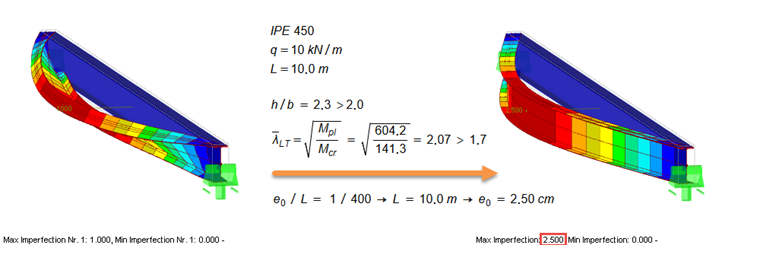Structural Analysis
Even though the influences of bow imperfections in the equations for stability designs of members according to Section 6.3 are already included, it is nevertheless important to consider a bow imperfection in the global analysis of frames if a structure or component is present that is sensitive to bow imperfections. This is defined in the German DIN standard DIN EN 1993‑1‑1:2010‑12, Section 5.3.2 (6).
Equation (5.8) is used to decide if a member is sensitive to bow imperfections:
where
is the degree of slenderness of a structural component in the considered plane which is determined by assuming a hinged support on both sides,
and
results in the known differentiation using the member coefficient from DIN 18800:
Member Imperfections
Flexural Buckling
The recommended bow imperfection's values result from DIN EN 1993‑1‑1:2010‑12, Sec. 5.3.2 (3), Table 5.1 as follows:
| Buckling Curve According to DIN EN 1993‑1‑1:2010‑12, Table 6.2 | Cross-Section Check | |
|---|---|---|
| Elastic e0,d/L | Plastic e0,d/L | |
| a0 | 1/350 | 1/300 |
| a | 1/300 | 1/250 |
| b | 1/250 | 1/200 |
| c | 1/200 | 1/150 |
| d | 1/150 | 1/100 |
If the determination of internal forces of the entire structure is based on the elastic analysis and if a cross-section design according to DIN EN 1993‑1‑1:2010‑12, Sec. 6.2.1 (7), Equation (6.2) is performed, Table NA.2 of DIN EN 1993‑1‑1/NA:2015‑08 [2] can be used:
| Buckling Curve According to DIN EN 1993‑1‑1:2010‑12, Table 6.2 | Cross-Section Check | |
|---|---|---|
| Elastic e0,d/L | Plastic e0,d/L | |
| a0 | 1/600 | Same as elastic, but Mpl/Mel-fold |
| a | 1/550 | |
| b | 1/350 | |
| c | 1/250 | |
| d | 1/150 | |
Lateral-Torsional Buckling
According to DIN EN 1993‑1‑1:2010‑12, Sec. 5.3.4 (3), for the torsional buckling analysis of elements subjected to bending according to the second-order analysis, the imperfection as bow imperfection around the weak axis with the value k ∙ e0,d (e0,d see Flexural Buckling) has to be assumed. The value of k = 0.5 is recommended. It is not necessary to apply any further torsional imperfection.
A cost-efficient approach is possible according to DIN EN 1993‑1‑1/NA:2015‑08 for I‑sections. According to NDP of 5.3.4(3), the bow imperfection can be assumed with the values of Table NA.3 instead of k ∙ e0,d.
| Cross-Section | Dimensions | Elastic Cross-Section Ratio e0,d/L | Plastic Cross-Section Ratio e0,d/L |
|---|---|---|---|
| Rolled I-Sections | h/b ≤ 2.0 | 1/500 | 1/400 |
| h/b > 2.0 | 1/400 | 1/300 | |
| Welded I-Sections | h/b ≤ 2.0 | 1/400 | 1/300 |
| h/b > 2.0 | 1/300 | 1/200 |
The specified values have to be doubled in the range of 0.7 ≤ λLT ≤ 1.3. This requirement goes back to a dissertation from 2008 at Ruhr University in Bochum, Germany, and has been added to the updated DIN 18800:2008‑11.
